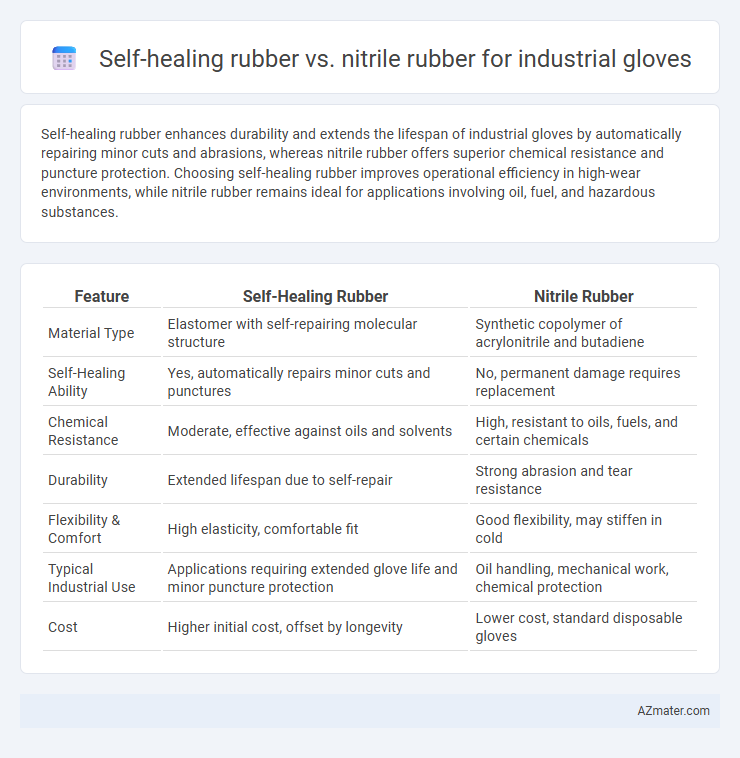Self-healing rubber enhances durability and extends the lifespan of industrial gloves by automatically repairing minor cuts and abrasions, whereas nitrile rubber offers superior chemical resistance and puncture protection. Choosing self-healing rubber improves operational efficiency in high-wear environments, while nitrile rubber remains ideal for applications involving oil, fuel, and hazardous substances.
Table of Comparison
| Feature | Self-Healing Rubber | Nitrile Rubber |
|---|---|---|
| Material Type | Elastomer with self-repairing molecular structure | Synthetic copolymer of acrylonitrile and butadiene |
| Self-Healing Ability | Yes, automatically repairs minor cuts and punctures | No, permanent damage requires replacement |
| Chemical Resistance | Moderate, effective against oils and solvents | High, resistant to oils, fuels, and certain chemicals |
| Durability | Extended lifespan due to self-repair | Strong abrasion and tear resistance |
| Flexibility & Comfort | High elasticity, comfortable fit | Good flexibility, may stiffen in cold |
| Typical Industrial Use | Applications requiring extended glove life and minor puncture protection | Oil handling, mechanical work, chemical protection |
| Cost | Higher initial cost, offset by longevity | Lower cost, standard disposable gloves |
Introduction to Industrial Gloves: Key Material Considerations
Self-healing rubber and nitrile rubber represent two advanced materials used in industrial gloves, each offering distinct benefits crucial for industrial applications. Self-healing rubber enhances durability by autonomously repairing minor punctures and cuts, reducing glove replacement frequency and increasing safety in hazardous environments. Nitrile rubber provides superior chemical resistance, puncture protection, and flexibility, making it ideal for handling oils, solvents, and other industrial chemicals.
What is Self-Healing Rubber?
Self-healing rubber is a type of elastomer engineered with reversible chemical bonds that enable it to automatically repair cuts and punctures, significantly extending the lifespan of industrial gloves. Compared to nitrile rubber, which relies on its chemical resistance and durability but lacks intrinsic repair capabilities, self-healing rubber offers enhanced operational safety and cost-efficiency through reduced glove replacements. This innovative material is particularly valuable in harsh industrial environments where glove integrity is critical for user protection and product performance.
Overview of Nitrile Rubber in Glove Manufacturing
Nitrile rubber is a synthetic elastomer widely used in industrial glove manufacturing due to its superior chemical resistance, puncture durability, and hypoallergenic properties compared to natural rubber. It offers excellent resistance to oils, fuels, and many solvents, making it ideal for automotive, chemical, and medical industries requiring reliable hand protection. The material's durability and cost-effectiveness contribute to its popularity, while innovations in formulation continue to improve flexibility and comfort for extended wear.
Comparative Durability: Self-Healing Rubber vs Nitrile Rubber
Self-healing rubber exhibits advanced durability by autonomously repairing micro-tears and punctures, significantly extending glove lifespan compared to conventional nitrile rubber. Nitrile rubber offers robust resistance to oils, chemicals, and abrasion but lacks inherent self-repair mechanisms, making it prone to cumulative wear and tear. The comparative durability distinctly favors self-healing rubber in high-wear industrial environments where longevity and reduced replacement frequency are critical.
Chemical Resistance: Performance in Harsh Environments
Self-healing rubber offers innovative chemical resistance by autonomously repairing micro-damages caused by solvents and oils, extending glove durability in harsh industrial environments. Nitrile rubber provides robust resistance against a broad spectrum of chemicals, including oils, acids, and solvents, making it a standard choice for industrial gloves in chemically aggressive applications. While nitrile excels in immediate chemical protection, self-healing rubber improves long-term performance through its regenerative properties, reducing glove failure rates and maintenance costs.
Puncture and Tear Resistance: Which Material Excels?
Self-healing rubber demonstrates superior puncture resistance by autonomously repairing micro-tears, significantly extending glove durability in high-risk industrial applications. Nitrile rubber offers excellent tear resistance and chemical protection, maintaining structural integrity under harsh conditions but lacks self-repairing properties. For industries prioritizing puncture resistance and longevity, self-healing rubber provides a cutting-edge advantage, while nitrile remains a robust choice for reliable tear resistance.
Cost-Effectiveness and Longevity Analysis
Self-healing rubber offers enhanced longevity by autonomously repairing minor damages, reducing the frequency of glove replacement and lowering long-term costs. Nitrile rubber, widely used in industrial gloves, provides excellent chemical resistance and durability at a competitive price point, making it cost-effective for routine use. When comparing cost-effectiveness, self-healing rubber excels in high-wear environments due to extended lifespan, whereas nitrile remains advantageous for general applications with lower initial investment.
User Comfort and Flexibility: A Side-by-Side Comparison
Self-healing rubber offers exceptional flexibility and user comfort due to its ability to autonomously repair small cuts and abrasions, maintaining glove integrity over time. Nitrile rubber provides high durability and chemical resistance but tends to be less flexible, which can reduce comfort during extended wear. For industrial gloves, self-healing rubber enhances dexterity and reduces glove replacements, while nitrile excels in protective performance under harsh chemical exposure.
Environmental Impact and Sustainability of Both Materials
Self-healing rubber offers enhanced durability by autonomously repairing microtears, reducing waste and extending glove lifecycle compared to traditional nitrile rubber, which often results in higher disposal rates due to wear and tear. Nitrile rubber, derived from petroleum-based synthetic polymers, carries a larger carbon footprint and slow biodegradability, raising environmental concerns in large-scale industrial use. The sustainability advantage of self-healing rubber lies in its potential to lower material consumption and landfill contributions, promoting greener manufacturing and waste management practices in the glove industry.
Choosing the Right Glove: Recommendations for Industries
Self-healing rubber gloves offer enhanced durability and extended service life by automatically repairing minor cuts and punctures, making them ideal for industries with high abrasion risks such as automotive manufacturing and heavy machinery maintenance. Nitrile rubber gloves provide excellent chemical resistance and puncture protection, suitable for chemical processing, laboratories, and food handling sectors requiring stringent hygiene standards. Selecting the right glove depends on balancing durability needs with chemical safety requirements to optimize worker protection and operational efficiency.

Infographic: Self-healing rubber vs Nitrile rubber for Industrial glove
 azmater.com
azmater.com